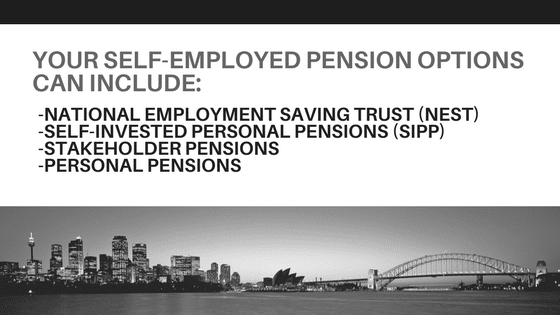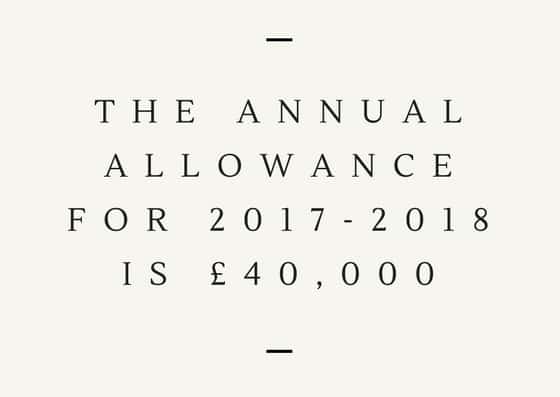Self-Employed Pensions: What Should You Be Doing?
When you’re self-employed, creating a pension can be easy to forget about. But with the State Pension predicted to pay out just £8,000 a year and retirement ages changing, it’s becoming increasingly important to make plans for your future.
Pensions can be a daunting topic, especially if it’s not something you’ve considered before. So we’ll break it down step by step. In this blog you will learn:
- The types of pension available to self-employed individuals
- The difference between stakeholder pensions and personal pensions
- The pension tax relief and annual allowance you’re entitled to
- What to consider when choosing a pension plan
First up, let’s define a pension.
What is a pension?
A pension is a saving pot for your retirement.
Once you retire, you can withdraw your money from the pension pot. Currently, you can do this from the age of 55 and above.
Alternatively, you can sell the cash to an insurance company in exchange for an annuity, which is a regular income until your death.
Why are self-employed pensions important?
- Your state pension, made up of your National Insurance Contributions, will only cover basic needs and the cost of living may change so that it covers less.
- There’s no guarantee that the current State Pension rules will remain the same, so it’s important to find a way to support yourself in retirement.
- As people tend to live longer, you’ll need more money to support yourself in retirement.
- Should you die before the age of 75, your pension scheme can be given to your next of kin as a lump sum. Inheritance tax deductions won’t apply.
Who pays into a pension?
If you’re self-employed, it’ll be your responsibility to pay into your pension. The Government will offer relief based on your contributions. These will be equal to the amount of income tax you pay.
- As a basic rate taxpayer, a £100 contribution will only cost you £80. The rest is tax relief.
- If you’re a higher rate taxpayer, a £100 contribution will only cost you £60.
- If you’re an additional rate taxpayer, this will go down to £55.
As mentioned above, your National Insurance Contributions go towards your State Pension. You can find out when you’ll start getting your State Pension using the government’s State Pension age calculator.
If you’re employed, your employer will legally have to contribute to your pension under Automatic Enrolment legislation, which can learn about here: https://www.kashflow.com/auto-enrolment/
Does Auto Enrolment apply to self-employed?
Automatic Enrolment doesn’t apply to self-employed individuals. If you don’t have an employer, it is therefore important to think about creating your own retirement funds.
The most effective way of doing this is to start a pension for yourself. There are several different types.
Self-Employed Pension Options
There are a number of self-employed pension options available. These include personal pensions, stakeholder pensions, self-invested personal pensions (SIPP) and the National Employment Saving Trust (NEST) scheme.
Here’s what you need to know about each.
What is a personal pension?
A personal pension is arranged and paid into by yourself, and not by an employer. Personal pensions are a common substitute for workplace pensions, and a good way to save for retirement.
They are usually classed as a defined contribution pension, which means you make payments into your pension on a regular basis.
Your pension pay-out will vary based on how much you paid in, how your pension investments have performed (as they can go up and down) and how you take your pension payment.
In a personal pension, you choose a provider and then decide how you want to pay your contributions.
How to pay personal pension contributions
You can make regular or individual lump sum payments to a personal pension. Some providers may require a minimum payment, so make sure you can afford to pay regular contributions.
There’s no limit to the amount you save towards retirement. There is, however, a limit to the amount you can get a tax relief on.
You can contribute 100% of your annual earnings before tax, up to £40,000. If you earn over £150,000, your contribution amount is reduced by £1 for every £2 earned over £150,000 until the tax-relief limit hits £10,000.
Choosing a personal pension provider
It’s important to check your pension provider is registered with the Financial Conduct Authority (FCA). They are the conduct regulator for 56,000 financial services firms in the UK and can give a clear steer on whether your favoured provider is reputable.
If you’re not sure which type of personal pension suits you, consider seeking independent financial advice. This advice is available from bodies like the Pensions Advisory Service. Alternatively, you can receive personalised advice from a professional accountant.
Differences between personal pension and self-invested personal pension
Self-invested personal pensions (SIPPs) work in roughly the same way as regular personal pensions. Their key difference is that SIPPs offer more investment flexibility.
Contributions to personal pensions are invested in the range of funds offered by the pension provider. With a SIPP, however, you have more freedom to choose your own investments.
So the key difference between a personal pension and a self-invested personal pension is the greater range of investment options available in a SIPP.
SIPP investment options
With a SIPP, you can choose to invest your pension in:
- Quoted stock and shares, both in the UK and overseas
- Unlisted shares
- Collective investments like OEICs
- Investment trusts
- Property and land insurance bonds – excluding most residential property
- Corporate bonds and much more
Generally speaking, SIPPs are only suitable for more experienced investors who are comfortable with making involved decisions on their investments.
Withdrawing a SIPP
A SIPP is a money purchase scheme. This means the money you withdraw on retirement will be impacted on by the amount you paid into the scheme, how long the money has been invested and other factors like the investment returns over this period of time.
What is a stakeholder pension?
Stakeholder pensions are another form of defined contribution pension. They are based on a set of minimum standards as defined by the government.
The aim of these standards is to make stakeholder pensions simple, affordable and accessible to people on lower incomes.
Why choose a stakeholder pension?
One of the key benefits of a stakeholder pension is that their minimum contributions are low and flexible.
Stakeholder pensions also feature capped charges to make them more affordable. These charges are currently capped at 1.5% per year for the first 10 years. After that, it’s capped at 1% per year.
Additionally, stakeholder pensions include a default investment strategy. There are, however, fewer investment options available in stakeholder pension schemes when compared to personal pension schemes.
How to pay stakeholder pension contributions
Anyone under 75 can contribute to a stakeholder pension scheme. You can start your investment from £20 per month, and you can invest up to £3,600 per year (including tax relief).
There are no penalties for changing your contributions, stopping them altogether, or moving to another scheme. This is useful for self-employed individuals with an irregular income.
Choosing a stakeholder pension provider
As with personal pensions, check with the FCA. You should also check your stakeholder pension provider is registered with the Pensions Regulator.
What is the National Employment Saving Trust (NEST)?
The National Employment Saving Trust (NEST) is a workplace pension set up by the government. The aim is to prepare companies for auto-enrolment, but they’ve recently included options for self-employed individuals too.
Why choose a NEST pension?
NEST pensions are quite flexible. If you join as a self-employed person but later become employed, you can keep contributing to the same retirement pot. If your employer uses NEST, they can also contribute to the same NEST retirement fund.
Similarly, if you move from employed to self-employed, you can update your NEST scheme and continue paying in.
How to pay NEST pension contributions
Pension contributions are made online, via Direct Debit or debit card. You can contribute as much as you like, over the minimum contribution level of £10.
As with other pension schemes, you may pay extra tax if your contributions exceed the annual allowance. If you join NEST, all your contributions will stay in your pension pot until your retirement date.
NEST pension charges
There are no set up or ongoing admin fees for NEST pensions. There are, however, charges for members.
- There is a contribution charge, which is 1.8% of each new contribution to the pension.
- There is an annual management charge (AMC) of 0.3% of the pension’s total value.
You can learn more about how the NEST charges are calculated here.
FAQ: Will I be charged for having a pension scheme? Most pension schemes, including personal pensions, include some charges. These cover the cost of administering the scheme. They can also cover investing contributions to build your retirement fund.
Annual allowance and pension tax relief
To encourage personal pensions, the government provide a minimum of 20% tax relief to payment made into pension schemes.
There’s no limit to the amount of pension schemes you can join. There is, however, a payment limit each year. This is called the annual allowance.
If your total payments into pension schemes exceed £40,000 then you will have to pay tax on the excess.
If your income including the value of pension contributions is over £150,000, and your income excluding pension contributions is over £110,000, then your annual allowance may be reduced from £40,000.
Pensions are “tax-efficient investments”. If you save into a defined contribution pension scheme, like those mentioned in this blog, you can take up to 25% of your pension as a tax-free lump sum. This is called a pension commencement lump sum or PCLS.
When using the rest of your pension pot, remember that you may have to pay income tax at a marginal rate.
For more information on the types of tax relief available, you can find an accountant.
Choosing a self-employed pension plan
When choosing a pension plan, give yourself time to shop around and find the best deal for you. Websites like Money Advice Service offer comparison charts, though the real key is to take your time and explore multiple avenues before making a decision.
When talking to potential pension providers, ask them for as much detail as possible. They are required to provide you with a “key facts document”, which summarises all the important details of their pension plan.
Check for additional charges. These can include admin fees and investment management charges. They can also include penalties for missed payment or early pay-outs.
Make sure you don’t agree to anything unless you are 100% happy with the shape of your investment. If in doubt, seek proper advice from financial experts.
One useful website to refer to is the Pension Wise website, which give advice on how to avoid pension scams. Visit their website here: https://www.pensionwise.gov.uk/en/scams
How much should I invest in a pension?
When it comes to deciding how much to invest, Martin Lewis recommends the following equation: when starting your pension, halve your age. Use this number as the percentage of your pre-tax salary to put into a pension.
So if you’re starting your pension at 30, you should be putting 15% of your pre-tax salary into a pension every year.
Where should I invest my pension?
The key to self-employed pensions investment is to diversify. If you choose a basic managed fund, then your pension investment will already be diversified. If it’s a specialised fund, however, you may want to look at different options to minimise your risks.
Ideally, your pension investments will grow over time. This is less likely if you invest in low-risk investments like cash and bonds.
It’s a good idea, therefore, to invest in shares. You should always investigate these thoroughly, and remember there is no guarantee they will result in high returns.
No head for numbers? KashFlow’s Accounting Software is designed to keep books simple for small businesses. Work from anywhere and keep your accounts under your control with our no-nonsense, cloud-based software. Start a free trial today, or request a free demo on 0344 815 5779.



